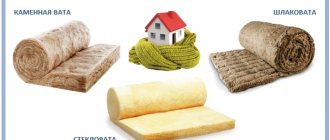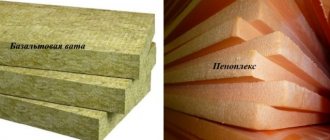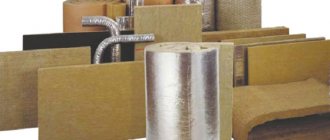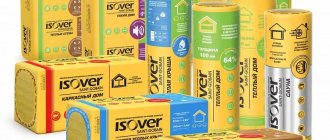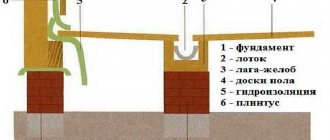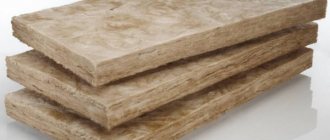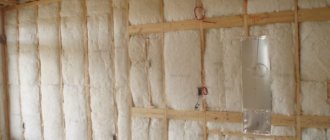When wanting to insulate a home, the question often arises: which is better, polyurethane foam or mineral wool. The second option is popular due to its low cost and availability. It is one of the most popular building materials. Polyurethane foam is not so popular, but its characteristics are at a high level. PPU is gradually taking the lead. Let's look at why this happens.
Insulation materials
Mineral wool: pros and cons
Mineral wool is a heat-insulating building material characterized by a fibrous structure. Its production is based on the processing of mineral raw materials extracted from the bowels of the earth. Additionally, synthetic binding fibers are introduced into the insulation composition.
Mineral wool
Mineral insulation is divided into:
- basalt;
- slag;
- glass
The positive qualities of mineral raw materials include:
- low degree of thermal conductivity of insulation. High thermal insulation characteristics and efficiency are observed;
- soundproofing properties of the material. The porous structure allows the use of thermal insulation to absorb noise from outside the house. The best option for residents of megacities;
- fire resistance. Mineral thermal insulation is not subject to fire. Can be used for insulation of flammable buildings;
- vapor permeability. The breathable structure of the insulation material allows the walls to “breathe”. This is important for the thermal insulation of a wooden structure. Air exchange will extend the life of a capital structure;
- ease and simplicity of installation work. No specialized education required. After studying the technology, you are allowed to take on insulating the house yourself;
- mineral wool is a biologically neutral material. It is not subject to rotting and attack by insects and rodents. Mold and mildew do not form on the surface;
- low pricing policy allows you to use mineral wool without obstacles;
- resistance to deformation and elasticity;
- long service life of building materials.
The disadvantages of mineral wool include:
- hygroscopicity. By absorbing moisture and getting wet, the material loses its quality. It is recommended to use high-quality waterproofing of walls;
- When temperatures reach above 300 degrees Celsius above zero, mineral wool evaporates dangerous toxic substances into the air. Under normal conditions this does not happen.
Mineral wool
The composition of this inorganic heat-insulating material includes sand and carbonate-basalt compounds. Thermal insulating qualities are achieved due to a special fibrous structure. There are air voids between the mineral wool fibers, which provide the desired thermal insulation effect. The obvious advantage of mineral wool is its elasticity. Due to this, installation of the heat insulator can be carried out without further securing it.
However, mineral wool is not without its disadvantages. And they are quite significant:
- Greater material consumption during installation.
- Additional costs for installing a ventilation duct and purchasing additional materials to ensure the preservation of the characteristics of mineral wool.
- Fragility.
- Negative impact on humans.
When laying mineral wool, you will need 20-30 percent more than polyurethane foam. In addition, waste caused by fitting must be taken into account. This is about 10%. When drawing up cost estimates, you should consider the purchase of insulating film and installation of a ventilation duct, which will increase costs. So the question of the cheapness of this material is quite controversial.
As for the service life, manufacturers guarantee a fairly long service life of mineral wool without loss of its characteristics. In practice, its heat-insulating properties last for ten years, and then only if the material has not been exposed to moisture.
Read more about mineral wool here
Mineral wool cannot be called unsafe. The fibers of this material themselves really do not pose a danger. However, formaldehyde in the material is harmful to the human body. A particular danger arises in the event of a fire, when the resins begin to melt from high temperatures.
Although mineral wool itself is a fire-resistant material, windproof and vapor barrier films are flammable, and without them laying the material is impossible.
All these arguments make you think about looking for an alternative. And it exists.
Polyurethane foam: pros and cons
The advantages of polyurethane foam include:
- tendency to “stick” to the materials from which the walls are made: brick, glass, concrete and metal surfaces. The shape of the wall and the presence of bulges do not matter. Good adhesion of the insulation allows you to avoid installing a mounting frame;
- polyurethane foam is made directly at the site of insulation. Transportation costs are minimized. Material costs for insulation are minimal;
- The insulation is extremely light. No surface heaviness is observed. Used for roof thermal insulation;
- polyurethane foam not only insulates the surface, it adds strength and reliability to them;
- the material is not afraid of high and low temperatures, or their sudden changes. Maintains the specified technical and operational parameters at temperatures of +200 – -200 degrees Celsius;
- no costs for vapor barrier, installation of a metal frame, counter slats, wind protection;
- The polyurethane foam coating simultaneously provides waterproofing of the surface. The structure is protected from the negative effects of moisture and water. The service life of the home increases;
- A distinctive feature of the insulation is its seamlessness. The surface is covered with thermal insulation without a single joint or seam. A solid fabric is formed, tightly fitting the structure.
Polyurethane foam
The disadvantages of building coatings include:
- negative effect of ultraviolet radiation on insulation. Under its influence, the thermal insulation coating is destroyed faster. It is important to organize high-quality protection of the coating from ultraviolet radiation. Suitable for painting, plastering, installing panels and other types of finishing of the building facade. This will protect the polyurethane foam from destruction and make the structure aesthetically attractive;
- polyurethane foam belongs to the thermal insulation of the second flammability group. It does not ignite, but begins to smolder. This stops as soon as the surface is cooled. But it is not recommended to use insulation for cladding flammable buildings.
Differences in the characteristics of mineral wool and polyurethane foam
Distinctive parameters of insulating building materials:
- thermal insulation qualities. Polyurethane foam as a spray creates a solid insulation sheet, without cracks or joints. Heat loss from the home is virtually eliminated. Mineral wool is not free from the formation of “cold bridges” through which heat escapes;
- toxicity. Polyurethane foam is non-toxic. Not flammable. Does not emit dangerous poisons into the atmosphere. Allowed for use in rooms with a high level of fire hazard. Although mineral wool is non-toxic, at high temperatures it emits toxic vapor that is dangerous to humans. She is smoldering. Not recommended for use in flammable areas;
- quality and speed of insulation installation. Cotton wool is produced in sheets. Laying requires the creation of lathing for additional fixation and cutting of the material. PPU in the form of a spray insulates the facade of the house quickly and efficiently;
- transportation. Although the cotton wool is light in weight, it is large in size. Takes up a lot of space. PPU is made directly at the point of use. Presented in the form of a small bottle. Doesn't take up much space;
- When working with cotton wool and polyurethane foam, it is recommended to use eye and respiratory protection and wear a protective suit;
- The cost of mineral wool is significantly cheaper, but if you compare how much money is required to transport it and how much scraps are left, then overall the difference is not great. Cotton wool consumption is 20-30% more than polyurethane foam. Plus, it is necessary to additionally provide vapor and waterproofing. Especially if you take into account the safety of the insulation - polyurethane foam;
- Vata is divided into several varieties. Various insulation options are used for walls, roofs and ceilings. PPU is universal. It is used in one variation for the entire home. There is no need to purchase different types of products. The task of insulating the house is simplified;
- polyurethane foam sprayer makes it easier to create the required insulation thickness. Cotton wool is purchased in the required size. It is difficult to change the thickness of the insulation on site. Is it possible to fold it in half?
- durability. The manufacturer indicates 50 years of service life for insulating materials. In practice, in just a couple of years, the material loses its thermal insulation qualities by 40%. The feasibility of using an insulating coating is 2-3 years. Polyurethane foam shows the best results, provided that reliable protection of the coating from ultraviolet radiation is provided. Otherwise, the material is not afraid of anything.
Areas of use
Areas of use of mineral insulation – wool:
- thermal insulation of the surface of walls and ceilings in the bathhouse;
- internal thermal insulation of enclosing structures in any position for all permanent buildings;
- insulation of ventilated facades of hinged type;
- thermal insulation of wet facade systems;
- insulation of industrial devices, networks and highways;
- improving the heat and sound insulation of the roof.
Insulation with mineral wool
Polyurethane foam is actively used not only in the construction, but also in the automotive, light, furniture and footwear industries. It is used as a filler for children's soft toys. The raw materials are environmentally safe and harmless to the human body of adults and children.
Scope of application of polyurethane foam in construction:
- thermal insulation of main pipes and low-temperature pipelines of the chemical industry;
- insulation of industrial and civil buildings;
- hydro- and thermal insulation of the foundation;
- roof insulation.
Insulation with polyurethane foam
Polyurethane foam
This is a much more modern and effective material . It is highly resistant to moisture. When water gets in, the thermal insulation characteristics do not deteriorate. This provides a wider scope of application for polyurethane foam. It can be used in places with high humidity.
The material is completely safe for humans . It does not emit toxic substances, so it is not capable of harming health. Can be used even in rooms with low temperatures (industrial refrigeration units for food storage).
Polyurethane foam has a significantly longer service life. It does not lose its properties for 25-30 years . And even after this period, the effectiveness practically does not decrease. The material does not rot, does not deteriorate from frost, precipitation and temperature changes. Ultraviolet radiation does not affect the structure of polyurethane foam. This allows it to be used in areas exposed to direct sunlight.
It has lower thermal conductivity compared to mineral wool, which provides higher thermal insulation performance. Capable of effectively retaining heat even at an ambient temperature of -100°C. Provides high-quality sound insulation. The material does not burn, which guarantees reliable fire safety.
During the installation process, the use of vapor insulation films is not required. The polyurethane foam itself is already a high-quality vapor barrier material.
Which insulation is better?
The construction industry presents a wide range of popular materials that can retain heat inside the house. These are polyurethane foam, mineral wool, polystyrene foam and much more. Their differences lie in the type of manufacture, environmental safety, period of operation, efficiency, nature of installation, and cost. The main thing is to choose the insulation that is suitable for a particular case. There are no low-quality materials, there is thermal insulation that is poorly suited to a particular situation.
If we compare mineral wool and polyurethane foam, the second option is superior in all areas. It has been more effective in heating a home for decades. Thanks to the solid structure and spraying, there are no gaps through which heat is lost. Polyurethane foam insulation is practical and safe. Ideal for insulating a private home.
Mineral building wool and polyurethane foam have many positive and negative qualities. What type of insulation to use depends on the specific case and purpose of the building. The choice rests with the owner of the house.
Polyurethane foam or PPU
Polyurethane foam is a relatively new material, but many people have already appreciated its advantages. For example, it is practically not afraid of moisture, which cannot be said about mineral wool. This is the first plus in favor of using this insulation.
Polyurethane foam is also safer for human health, since it is non-toxic and has good fire safety. It is worth saying that this material is allowed to be used even in refrigeration units where food is stored. This is another definite plus in favor of PPU.
Polyurethane foam is one of the most durable materials, its service life is approximately 25-30 years. At the same time, polyurethane foam insulation does not rot, it is not afraid of fungi and mold, low temperatures, humidity, and sunlight. As you can see, polyurethane foam has a lot of advantages...
Due to the fact that the thermal conductivity coefficient of polyurethane foam is lower than that of mineral wool, this material is able to retain heat even at a temperature of -100°C. Polyurethane foam also has excellent sound insulation properties. Among other things, it does not support combustion, which is also an important advantage. When insulating polyurethane foam, there is no need to install additional vapor barrier or wind protection.
As you can see, polyurethane foam, compared to mineral wool, has excellent thermal insulation properties, good fire safety, moisture resistance and excellent practicality. If you really need good insulation, then you should turn your attention to polyurethane foam!
